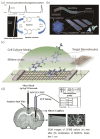Sensing and Stimulation Applications of Carbon Nanomaterials in Implantable Brain-Computer Interface
- PMID: 36982255
- PMCID: PMC10048878
- DOI: 10.3390/ijms24065182
Sensing and Stimulation Applications of Carbon Nanomaterials in Implantable Brain-Computer Interface
Abstract
Implantable brain-computer interfaces (BCIs) are crucial tools for translating basic neuroscience concepts into clinical disease diagnosis and therapy. Among the various components of the technological chain that increases the sensing and stimulation functions of implanted BCI, the interface materials play a critical role. Carbon nanomaterials, with their superior electrical, structural, chemical, and biological capabilities, have become increasingly popular in this field. They have contributed significantly to advancing BCIs by improving the sensor signal quality of electrical and chemical signals, enhancing the impedance and stability of stimulating electrodes, and precisely modulating neural function or inhibiting inflammatory responses through drug release. This comprehensive review provides an overview of carbon nanomaterials' contributions to the field of BCI and discusses their potential applications. The topic is broadened to include the use of such materials in the field of bioelectronic interfaces, as well as the potential challenges that may arise in future implantable BCI research and development. By exploring these issues, this review aims to provide insight into the exciting developments and opportunities that lie ahead in this rapidly evolving field.
Keywords: carbon nanomaterials; implantable brain–computer interface; sensing and stimulation.
Conflict of interest statement
The authors declare no conflict of interest.
Figures






References
-
- Jorgenson L.A., Newsome W.T., Anderson D.J., Bargmann C., Brown E.N., Deisseroth K., Donoghue J.P., Hudson K.L., Ling G.S.F., MacLeish P.R., et al. The brain initiative: Developing technology to catalyse neuroscience discovery. Philos. Trans. R. Soc. B Biol. Sci. 2015;370:20140164. doi: 10.1098/rstb.2014.0164. - DOI - PMC - PubMed
-
- Du Z., Lu Y., Wei P., Deng C., Li X. Progress in devices and materials for implantable multielectrode arrays. Acta Phys. Chim. Sin. 2020;36:2007004. doi: 10.3866/PKU.WHXB202007004. - DOI
-
- Wise K., Anderson D., Hetke J., Kipke D., Najafi K. Wireless implantable microsystems: High-density electronic interfaces to the nervous system. Proc. IEEE. 2004;92:76–97. doi: 10.1109/JPROC.2003.820544. - DOI
Publication types
MeSH terms
Grants and funding
- 2018B030331001, 2018B030338001/Key-Area Research and Development Program of Guangdong Province
- 2022ZD0209800/Scientific and Technological Innovation 2030 Key Project of Ministry of Science and Technology of China
- 31930047,31700936/NSFC project
- 2020YFC2008503, 2018YFA0701400, 2017YFC1310503/National Key R&D Program of China
- 2017A030310496/Doctoral Initiation Project of the Guangdong Province
LinkOut - more resources
Full Text Sources

